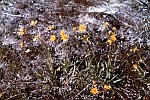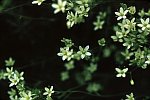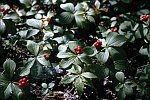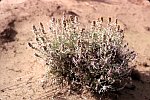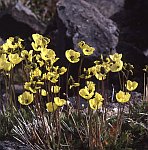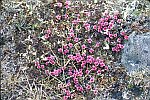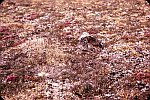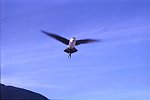The Plants and Animals of Northern Canada
Author: Jennifer Hamel Page 1 | Page 2 | Page 3
Flowering Plants
Forget me nots, arctic poppies, and saxifrages can be found throughout the arctic tundra.
Forget-me-nots grow in the arctic near gravelled banks and snow patches. These flowers grow in warmer climates, too – you might find them in your backyard!
During the day, the arctic poppy follows the sun across the sky, just like a sunflower. This helps the poppy to get as much nourishment from the sun as possible.
The name saxifrage (SAK-si-fridge) comes from the Latin words Saxum (rock) and frango (to break). Saxifrage was given this name because it likes to plant its roots in the cracks and crevices of rocks. Saxifrage plants have leathery leaves and flowers on a long stem. It is the first to bloom during the arctic summer, and has small hairs on its leaves which help to protect it from the dry arctic wind. Purple saxifrage is the official territorial flower of Canada's third and newest territory, Nunavut.
Fauna – Birds
The eider duck lives along the coastline of Canada's arctic, as well as in other artic countries, like Norway, Iceland, and Russia. The eider duck can dive underwater to catch its food - it even uses its wings to swim underwater! If something scares these ducks, they can fly right out of the water into the air.
Eider ducks like to eat crustaceans, or shellfish, like molluscs, mussels, and clams, as well as other small marine animals, like starfish and sea urchins. They have very sensitive bills that help them find their food in the mud.
Eider ducks produce warm down feathers. When these soft feathers fall out, the ducks use them to line their nests. Their down is also used by humans to make quilts and pillows. Maybe you have an eider duck feather comforter at home on your bed!
Terns are members of the gull family that nest north of the tree line (on the tundra). They make their nests out of grass, sand or small pebbles. Their nests are quite simple, usually nothing more than small holes scraped into the ground.
Terns are very aggressive and attack other animals that enter their territory. They are usually grey and white and their head feathers turn black in the spring and summer. Terns have pointed wings and their tail is forked. They like to dive into the water when they feed. Arctic terns eat small fish, shrimp, krill, insects, and small invertebrates.
Jaegers (YAY-gurr) are seabirds that have long pointed wings, a hooked bill, and webbed feet. They are very aggressive predators. Instead of catching food for themselves, they attack gulls and terns while they are flying and force them to spit out their food. After the gull or tern has thrown up its food, the jaeger catches the vomit in midair. While jaegers are nesting, they eat small mammals, birds, fish and insects.
Although jaegers are marine birds that live on the ocean, they nest in the tundra. Jaegers make a hollow nest in the bare ground, which they sometimes line with moss or grass. Female jaegers lay two eggs each year and both the male and the female take care of the eggs until they are hatched.
